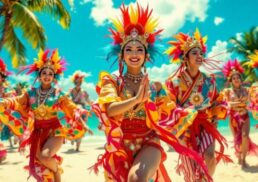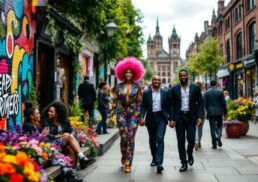In search of an understanding of the country of Philippines? This article peers into a nation of over 7,600 islands, uncovering the Philippines’ landscapes, cultures, and society. Learn about its stewardship of natural wonders, the hustle of its cities, and the governance that weaves these islands into a unified republic.
Table of Contents
Key Takeaways
The Philippines consists of over 7,600 islands showcasing geological diversity, ranging from urban landscapes to unspoiled beaches and natural wonders like the Ifugao Rice Terraces, and is committed to environmental conservation efforts.
As a crucial ASEAN founding member, the Philippines plays a significant role in shaping the region’s diplomatic agenda and fostering economic relations, especially with key trade partners like the U.S. and China.
The cultural identity of the Philippines is reflected in its warm hospitality, rich linguistic history comprising Spanish and American influence, deep-rooted Catholic traditions, and commitment to biodiversity conservation and species protection.
Exploring the Philippine Archipelago

Nestled in the heart of Southeast Asia, the Philippines comprises an archipelago consisting of over 7,600 islands, a testament to the nation’s geological diversity. Bordered by the vast waters of the South China Sea, the Philippine Sea, and the Celebes Sea, the islands range from the sprawling urban landscape of Manila in Luzon to the unspoiled beaches of the southern islands like those in Mindanao. Among these diverse regions, south central Luzon also offers a rich cultural and natural experience for visitors.
Traveling across this land, one can marvel at a diverse spectrum of landscapes, which includes the volcanic magnificence of Taal and Mayon, as well as the iconic Chocolate Hills of Bohol. The islands are not only a feast for the eyes but also a testament to the country’s dynamic earth, with a tropical climate shaped by monsoonal patterns and the annual challenge of tropical cyclones.
The fertile soils of the Philippine archipelago, nourished by volcanic ash and the proximity to the Pacific Ocean, sustain a thriving agricultural sector, exemplified by the mesmerizing Ifugao Rice Terraces. These terraces are not only a source of sustenance but also a symbol of the intricate relationship between Filipinos and their environment. Moreover, the commitment to protecting this unique ecosystem is evident in places like Calauit Island, where conservation initiatives allow for intimate interactions with wildlife such as the dugong in an eco-conscious manner.
The Heart of Southeast Asia
Being a significant entity in Southeast Asia, the Philippines holds sway over the region, fortified by its status as a founding member of ASEAN. This bloc is a cornerstone for fostering solidarity and cooperation among neighboring nations, paving the way for a unified and prospering Southeast Asia. The Philippines’ role in ASEAN goes beyond regional camaraderie; it shapes the agenda that ensures Southeast Asia’s voice resonates on the global stage.
The foundation of Philippine diplomacy lies in promoting international norms within ASEAN, fostering strategic consonance among varied state interests. This is exemplified by its collaborative efforts with other countries such as Vietnam, reflecting a deeper commitment to regional cooperation. Additionally, the strategic partnership with the United States underscores the geopolitical significance of ASEAN and the Philippines in America’s Asia-Pacific rebalancing.
On the economic front, the Philippines establishes essential ties with other countries, particularly through its trade relations. Its relationships with the United States and China, each accounting for 14% of its external trade, cement its position as a linchpin in the regional economy. However, the tapestry of ASEAN is not without its challenges; the lack of a unified strategic vision and the complexities of regional tensions, notably with China, create economic ripples that the Philippines must navigate with prudence.
Urban Vibrance and Rural Charm

The urban pulse of the Philippines is most evident in major cities such as Manila, the nation’s capital, and Quezon City, the most populated. These cities embody the nation’s progress with their modern amenities and bustling economies, offering a vibrant lifestyle supported by a broad array of employment and educational opportunities. The cultural melting pot found in these metropolitan areas brims with an array of culinary delights, events, and entertainment, reflecting the Philippines’ multicultural fabric and cosmopolitan allure.
In stark contrast to this urban dynamism, the rural allure of the Philippines, an ethnically diverse country, is deeply embedded in its tranquil villages. Agriculture takes center stage here, with traditional values guiding the rhythms of life. The vast majority of the country’s rural populace is tied to the land, cultivating rice, coconuts, and other crops that form the backbone of the Philippine economy.
The Filipino Spirit: Language, Arts, and Festivals
Filipinos, renowned for their warm hospitality and courteous demeanor, frequently address others using honorifics such as ‘Sir’ or ‘Ma’am’, and familial terms like ‘Tito/Tita’ and ‘Kuya/Ate’. Even in casual conversation, the use of ‘Po’ and ‘Opo’ signify deep respect. The country’s official language reflects its historical tapestry, with Spanish and American influences evident in everyday communication due to its past as a Spanish colony and later, under American administration following the Spanish American War.
Christianity, predominantly Roman Catholicism, exerts a profound influence on the nation’s cultural identity and is interwoven into the fabric of daily life and grand festivals alike. The national anthem, ‘Lupang Hinirang’, with its stirring Tagalog lyrics, which is the national language, and the Philippine flag, symbolizing peace, justice, courage, and the country’s geographical unity, are emblematic of the nation’s pride and historical journey, including resilience through events like World War II.
Nature’s Playground: Wildlife and Conservation

The Philippines, aside from being a cultural gem, is also a sanctuary of biodiversity, globally acknowledged for its distinctive wildlife. The islands are home to a myriad of species found nowhere else on earth, including the majestic Philippine eagle and the enigmatic tarsier. However, this rich biodiversity is under threat, with many species teetering on the brink of extinction, making conservation efforts a top priority.
Initiatives like the Protect Wildlife Project, launched to counter wildlife exploitation and habitat degradation, play a critical role in safeguarding vital ecosystems such as Palawan Island and the Sulu Archipelago. Organizations like Conservation International collaborate with the Philippine government and local NGOs, leveraging research and innovation to formulate informed conservation strategies.
Community engagement is crucial to these efforts, as local stewardship ensures both sustainable practices and the preservation of the Philippines’ natural heritage. Such initiatives educate communities and support transitions to sustainable livelihoods, vital for the long-term health of the country’s ecosystems.
Governance and Law in the Republic
The Republic of the Philippines functions under a presidential representative democratic constitutional system, where the President assumes the dual role of the head of state and government. The government’s structure is tripartite, featuring a bicameral Congress, an executive branch led by the President, and a judiciary topped by the Supreme Court.
A unique blend of civil, common, Islamic, and customary laws form the country’s legal framework, reflecting its diverse legal and cultural history. The President, as the chief executive, oversees all executive departments, with official appointments scrutinized by the Commission on Appointments. The Vice President’s role is distinct, with a possibility for re-election contrasting the President’s single-term limit. In times of crisis, the President may declare martial law to maintain order and security.
Local governance in the Philippines is tiered, ranging from:
Autonomous and administrative regions
Provinces
Cities
Municipalities
Barangays (the smallest local government units)
Independent constitutional commissions and the Office of the Ombudsman serve as watchdogs, ensuring integrity within government operations and holding officials accountable, particularly concerning graft and corruption.
Connecting the Islands: Infrastructure and Transportation
Covering the expansive distances of the Philippine archipelago, a comprehensive transport infrastructure binds the islands together. The transport infrastructure includes:
Roads
Ports
Airports
Waterways
These modes of transportation play a part in knitting together the country’s diverse regions, facilitating both travel and commerce. Motorcycles and tricycles dominate the roads, while the iconic jeepneys provide a quintessential Filipino travel experience.
The maritime sector is robust, with a fleet that includes container ships, oil tankers, and bulk carriers. However, the country’s waterways are somewhat limited, accommodating only vessels with a draft of less than 1.5 meters. Rail transit, although currently limited, is an area of potential growth for enhancing the connectivity of the archipelago.
Learn more, visit Explore Filipino Culture in These Historic Cities.
Summary
The Philippines, with its enchanting mosaic of islands, vibrant cities, rich cultural heritage, and lush natural environment, presents an alluring destination for both the intrepid traveler and the curious mind. From the bustling streets of Manila to the tranquil villages where time seems to stand still, the country offers a journey through a myriad of experiences that speak to the heart and soul.
In the embrace of this archipelago lies a spirit of resilience and joy, an ecosystem teeming with life, and a society that is as complex as it is captivating. Whether you’re seeking adventure, cultural immersion, or a deeper understanding of governance and infrastructure, the Philippines promises a story at every turn, awaiting your discovery.
Frequently Asked Questions
Does PH mean Philippines?
Yes, PH stands for the Philippines. It is the ISO country code for the country located in Southeast Asia.
Is the Philippines a country or a US territory?
The Philippines is not a US territory. It was formerly a US territory but gained its full independence in 1946.
What is the real name of the country Philippines?
The real name of the country Philippines is the Republic of the Philippines, which was proclaimed in 1946, with a government patterned after the United States. This is based on the provisions of the 1987 Constitution.
Is the Philippines a good country to live in?
Yes, the Philippines is a good country to live in due to its mix of cultures, landscapes, and hospitable people. It’s important to secure international health insurance for peace of mind.
What makes the Philippines a biodiversity hotspot?
The Philippines is considered a biodiversity hotspot due to its large number of endemic species, including the Philippine eagle and the tarsier, which contribute to its rich variety of native wildlife.









